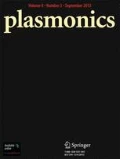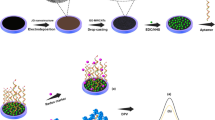Abstract
Currently, no methods exist for the definitive diagnosis of AD premortem. β-amyloid, the primary component of the senile plaques found in patients with this disease, is believed to play a role in its neurotoxicity. We are developing a nanoshell substrate, functionalized with sialic acid residues to mimic neuron cell surfaces, for the surface-enhanced Raman detection of β-amyloid. It is our hope that this sensing mechanism will be able to detect the toxic form of β-amyloid, with structural and concentration information, to aid in the diagnosis of AD and provide insight into the relationship between β-amyloid and disease progression. We have been successfully able to functionalize the nanoshells with the sialic acid residues to allow for the specific binding of β-amyloid to the substrate. We have also shown that a surface-enhanced Raman spectroscopy response using nanoshells is stable and concentration-dependent with detection into the picomolar range.







Similar content being viewed by others
References
Ferri CP, Prince M, Brayne C, Brodaty H, Fratiglioni L, Ganguli M, Hall K, Hasegawa K, Hendrie H, Huang YQ, Jorm A, Mathers C, Menezes PR, Rimmer E, Scazufca M (2005) Global prevalence of dementia: a Delphi consensus study. Lancet 366(9503):2112–2117
Hebert LE, Scherr PA, Bienias JL, Bennett DA, Evans DA (2003) Alzheimer disease in the US population-prevalence estimates using the 2000 census. Arch Neurol 60(8):1119–1122
Hardy J, Selkoe DJ (2002) The amyloid hypothesis of Alzheimer’s disease: progress and problems on the road to therapeutics. Science 297:353–356
Minino AM, Heron MP, Smith BL (2006) Deaths: preliminary data for 2004. Natl Vital Stat Rep 54(19):1–50
Selkoe DJ (2001) Alzheimer’s disease: genes, proteins, and therapy. Physiol Rev 81(2):741–766
Ernst RL, Hay JW (1994) The U.S. economic and social costs of Alzheimer’s disease revisited. Am J Public Health 84(8):1261–1264
Ariga T, Kobayashi K, Hasegawa A, Kiso M, Ishida H, Miyatake T (2001) Characterization of high-affinity binding between gangliosides and amyloid beta-protein. Arch Biochem Biophys 388(2):225–230
Bard F, Cannon C, Barbour R, Burke RL, Games D, Grajeda H, Guido T, Hu K, Huang JP, Johnson-Wood K, Khan K, Kholodenko D, Lee M, Lieberburg I, Motter R, Nguyen M, Soriano F, Vasquez N, Weiss K, Welch B, Seubert P, Schenk D, Yednock T (2000) Peripherally administered antibodies against amyloid beta-peptide enter the central nervous system and reduce pathology in a mouse model of Alzheimer disease. Nat Med 6(8):916–919
Bergamaschini L, Rossi E, Storini C, Pizzimenti S, Distaso M, Perego C, De Luigi A, Vergani C, De Simoni MG (2004) Peripheral treatment with enoxaparin, a low molecular weight heparin, reduces plaques and beta-amyloid accumulation in a mouse model of Alzheimer’s disease. J Neurosci 24(17):4181–4186
Blanchard BJ, Chen A, Rozeboom LM, Stafford KA, Weigele P, Ingram VM (2004) Efficient reversal of Alzheimer’s disease fibril formation and elimination of neurotoxicity by a small molecule. Proc Natl Acad Sci USA 101(40):14326–14332
DeMattos RB, Bales KR, Cummins DJ, Dodart JC, Paul SM, Holtzman DM (2001) Peripheral anti-A beta antibody alters CNS and plasma A beta clearance and decreases brain A beta burden in a mouse model of Alzheimer’s disease. Proc Natl Acad Sci USA 98(15):8850–8855
Etcheberrigaray R, Tan M, Dewachter I, Kuiperi C, Van der Auwera I, Wera S, Qiao LX, Bank B, Nelson TJ, Kozikowski AP, Van Leuven F, Alkon DL (2004) Therapeutic effects of PKC activators in Alzheimer’s disease transgenic mice. Proc Natl Acad Sci USA 101(30):11141–11146
Gelinas DS, DaSilva K, Fenili D, George-Hyslop PS, McLaurin J (2004) Immunotherapy for Alzheimer’s disease. Proc Natl Acad Sci USA 101:14657–14662
Ghanta J, Shen CL, Kiessling LL, Murphy RM (1996) A strategy for designing inhibitors of beta-amyloid toxicity. J Biol Chem 271(47):29525–29528
Hock C, Konietzko U, Streffer JR, Tracy J, Signorell A, Muller-Tillmanns B, Lemke U, Henke K, Moritz E, Garcia E, Wollmer MA, Umbricht D, de Quervain DJF, Hofmann M, Maddalena A, Papassotiropoulos A, Nitsch RM (2003) Antibodies against beta-amyloid slow cognitive decline in Alzheimer’s disease. Neuron 38(4):547–554
Mandavilli A (2006) The amyloid code. Nat Med 12(7):747–751
Mount C, Downton C (2006) Alzheimer disease: progress or profit? Nat Med 12(7):780–784
Patel D, Henry J, Good T (2006) Attenuation of beta-amyloid induced toxicity by sialic acid-conjugated dendrimeric polymers. Biochim Biophys Acta 1760(12):1802–1809
Brookmeyer R, Gray S, Kawas C (1998) Projections of Alzheimer’s disease in the United States and the public health impact of delaying disease onset. Am J Public Health 88(9):1337–1342
Davis PC, Gray L, Albert M, Wilkinson W, Hughes J, Heyman A, Gado M, Kumar AJ, Destian S, Lee C, Duvall E, Kido D, Nelson MJ, Bello J, Weathers S, Jolesz F, Kikinis R, Brooks M (1992) The consortium to establish a registry for Alzheimers-disease (Cerad) .3. Reliability of a standardized Mri evaluation of Alzheimers-disease. Neurology 42(9):1676–1680
Duara R, Grady C, Haxby J, Sundaram M, Cutler NR, Heston L, Moore A, Schlageter N, Larson S, Rapoport SI (1986) Positron emission tomography in Alzheimers-disease. Neurology 36(7):879–887
Haxby JV, Grady CL, Duara R, Schlageter N, Berg G, Rapoport SI (1986) Neocortical metabolic abnormalities precede non-memory cognitive defects in early Alzheimers-type dementia. Arch Neurol 43(9):882–885
Blennow K (2004) CSF biomarkers for mild cognitive impairment. J Intern Med 256:224–234
Mattson MP, Mark RJ, Furukawa K, Bruce AJ (1997) Disruption of brain cell ion homeostasis in Alzheimer’s disease by oxy radicals, and signaling pathways that protect therefrom. Chem Res Toxicol 10(5):507–517
Rapport M, Dawson HN, Binder LI, Vitek MP, Ferreira A (2002) Tau is essential to β-amyloid-induced neurotoxicity. Proc Natl Acad Sci USA 99:6364–6369
Small GW (2002) Brain-imaging surrogate markers for detection and prevention of age-related memory loss. J Mol Neurosci 19(1–2):17–21
Varadarajan S, Yatin S, Aksenova M, Butterfield DA (2000) Review: Alzheimer’s amyloid β-peptide-associated free radical oxidative stress and neurotoxicity. J Struct Biol 130:184–208
Walsh DM, Klyubin I, Fadeeva JV, Rowan MJ, Selkoe DJ (2002) Amyloid-beta oligomers: their production, toxicity and therapeutic inhibition. Biochem Soc Trans 30:552–557
Wang SSS, Rymer DL, Good TA (2001) Reduction in cholesterol and sialic acid content protects cells from the toxic effects of beta-amyloid peptides. J Biol Chem 276(45):42027–42034
Zetterberg H, Wahnlund L-O, Blennow K (2003) Cerebrospinal fluid markers for prediction of Alzheimer’s disease. Neurosci Lett 352:67–69
Cleary JP, Walsh DM, Hofmeister JJ, Shankar GM, Kuskowski MA, Selkoe DJ, Ashe KH (2005) Natural oligomers of the amyloid-protein specifically disrupt cognitive function. Nat Neurosci 8(1):79–84
Gong Y, Chang L, Viola KL, Lacor PN, Lambert MP, Finch CE, Krafft GA, Klein WL (2003) Alzheimer’s disease-affected brain: presence of oligomeric Aβ ligands (ADDLs) suggests a molecular basis for reversible memory loss. Proc Natl Acad Sci USA 100(18):10417–10422
Hardy J, Selkoe DJ (2002) Medicine—the amyloid hypothesis of Alzheimer’s disease: progress and problems on the road to therapeutics. Science 297(5580):353–356
Lee S, Fernandez EJ, Good TA (2007) Role of aggregation conditions in structure, stability, and toxicity of intermediates in the Aβ fibril formation pathway. Protein Sci 16(4):723–732
Lorenzo A, Yankner BA (1994) Beta-amyloid neurotoxicity requires fibril formation and is inhibited by Congo red. Proc Natl Acad Sci USA 91(25):12243–12247
Selkoe DJ, Schenk D (2003) Alzheimer’s disease: molecular understanding predicts amyloid-based therapeutics. Annu Rev Pharmacol Toxicol 43:545–584
Haes AJ, Chang L, Klein WL, Van Duyne RP (2005) Detection of a biomarker for Alzheimer’s disease from synthetic and clinical samples using a nanoscale optical biosensor. J Am Chem Soc 127(7):2264–2271
Haes AJ, Hall WP, Chang L, Klein WL, Van Duyne RP (2004) A localized surface plasmon resonance biosensor: first steps toward an assay for Alzheimer’s disease. Nano Lett 4(6):1029–1034
Georganopoulou DG, Chang L, Nam JM, Thaxton CS, Mufson EJ, Klein WL, Mirkin CA (2005) Nanoparticle-based detection in cerebral spinal fluid of a soluble pathogenic biomarker for Alzheimer’s disease. Proc Natl Acad Sci USA 102(7):2273–2276
Kneipp K, Wang Y, Kneipp H, Perelman LT, Itzkan I, Dasari R, Feld MS (1997) Single molecule detection using surface-enhanced Raman scattering (SERS). Phys Rev Lett 78(9):1667–1670
Kneipp K, Wang Y, Kneipp H, Itzkan I, Dasari RR, Feld MS (1996) Population pumping of excited vibrational states by spontaneous surface-enhanced Raman scattering. Phys Rev Lett 76(14):2444–2447
Nie SM, Emery SR (1997) Probing single molecules and single nanoparticles by surface-enhanced Raman scattering. Science 275(5303):1102–1106
Fleischmann M, Hendra PJ, McQuillan AJ (1973) Raman-spectra from electrode surfaces. J Chem Soc Chem Commun (3):80–81
Jeanmaire DL, Vanduyne RP (1977) Surface raman spectroelectrochemistry. 1. Heterocyclic, aromatic, and aliphatic-amines adsorbed on anodized silver electrode. J Electroanal Chem 84(1):1–20
Baker GA, Moore DS (2005) Progress in plasmonic engineering of surface-enhanced Raman-scattering substrates toward ultra-trace analysis. Anal Bioanal Chem 382(8):1751–1770
Kneipp K, Kneipp H, Itzkan I, Dasari RR, Feld MS (2002) Surface-enhanced Raman scattering and biophysics. J Phys Condens Matter 14(18):R597–R624
Oldenburg SJ, Jackson JB, Westcott SL, Halas NJ (1999) Infrared extinction properties of gold nanoshells. Appl Phys Lett 75(19):2897–2899
Jackson JB, Halas NJ (2003) Controlling the surface enhanced Raman effect on nanoshells in a film geometry. Abstr Pap Am Chem Soc 225:U447
Jackson JB, Halas NJ (2004) Surface-enhanced Raman scattering on tunable plasmonic nanoparticle substrates. Proc Natl Acad Sci USA 101(52):17930–17935
Oldenburg SJ, Westcott SL, Averitt RD, Halas NJ (1999) Surface enhanced Raman scattering in the near infrared using metal nanoshell substrates. J Chem Phys 111(10):4729–4735
Zhu ZH, Zhu T, Liu ZF (2004) Raman scattering enhancement contributed from individual gold nanoparticles and interparticle coupling. Nanotechnology 15(3):357–364
Li KR, Stockman MI, Bergman DJ (2003) Self-similar chain of metal nanospheres as an efficient nanolens. Phys Rev Lett 91(22)
ChooSmith LP, GarzonRodriguez W, Glabe CG, Surewicz WK (1997) Acceleration of amyloid fibril formation by specific binding of A beta-(1–40) peptide to ganglioside-containing membrane vesicles. J Biol Chem 272(37):22987–22990
Kakio A, Nishimoto S, Yanagisawa K, Kozutsumi Y, Matsuzaki K (2001) Cholesterol-dependent formation of GM1 ganglioside-bound amyloid beta-protein, an endogenous seed for Alzheimer amyloid. J Biol Chem 276(27):24985–24990
Kakio A, Yano Y, Takai D, Kuroda Y, Matsumoto O, Kozutsumi Y, Matsuzaki K (2004) Interaction between amyloid beta-protein aggregates and membranes. J Pept Sci 10(10):612–621
Matsuzaki K, Horikiri C (1999) Interactions of amyloid beta-peptide (1–40) with ganglioside-containing membranes. Biochemistry 38(13):4137–4142
Wakabayashi M, Okada T, Kozutsumi Y, Matsuzaki K (2005) GM1 ganglioside-mediated accumulation of amyloid beta-protein on cell membranes. Biochem Biophys Res Commun 328(4):1019–1023
Williamson MP, Suzuki Y, Bourne NT, Asakura T (2006) Binding of amyloid beta-peptide to ganglioside micelles is dependent on histidine-13. Biochem J 397:483–490
Iconomidou VA, Chryssikos GD, Gionis V, Hoenger A, Hamodrakas SJ (2003) FT-Raman spectroscopy as diagnostic tool of Congo red binding to amyloids. Biopolymers 72(3):185–192
Miura T, Yamamiya C, Sasaki M, Suzuki K, Takeuchi H (2002) Binding mode of Congo red to Alzheimer’s amyloid beta-peptide studied by UV Raman spectroscopy. J Raman Spectrosc 33(7):530–535
Khurana R, Uversky VN, Nielsen L, Fink AL (2001) Is Congo red an amyloid-specific dye? J Biol Chem 276(25):22715–22721
Acknowledgements
The authors acknowledge the support of the National Institutes of Health (grant no. STTR-1R41AG025586-01 and grant no. R21-NS050346-01). The authors acknowledge the support of the Air Force (STTR FA9550-05-C-0019). Hope Beier acknowledges the support of a National Science Foundation Graduate Research Fellowship.
Author information
Authors and Affiliations
Corresponding author
Rights and permissions
About this article
Cite this article
Beier, H.T., Cowan, C.B., Chou, IH. et al. Application of Surface-Enhanced Raman Spectroscopy for Detection of Beta Amyloid Using Nanoshells. Plasmonics 2, 55–64 (2007). https://doi.org/10.1007/s11468-007-9027-x
Received:
Accepted:
Published:
Issue Date:
DOI: https://doi.org/10.1007/s11468-007-9027-x




